Harassment Warning Letter
[Your Name]
[Your Address]
[City, State, Zip Code]
[Email Address]
[Phone Number]
[Date]
[Recipient's Name]
[Recipient's Address]
[City, State, Zip Code]
Subject: Harassment Warning Letter
Dear [Recipient's Name],
I hope this letter finds you well. The purpose of this communication is to address a matter of significant concern that has come to my attention. It has come to my notice that you have engaged in behavior that constitutes harassment towards [victim's name], and I am writing this letter to formally warn you that such behavior is unacceptable and will not be tolerated.
Harassment, in any form, is a serious violation of personal boundaries and can have severe negative consequences for the victim's mental, emotional, and physical well-being. Our society and workplace should be environments where everyone feels safe, respected, and treated with dignity. Harassment undermines these values and creates a hostile atmosphere that can negatively impact the overall well-being of all individuals involved.
The specific incidents reported, which have led to this warning, include [describe the incidents and their dates as accurately as possible]. These actions have caused distress to the victim and are in violation of our organization's policies on harassment and respectful conduct.
I want to be clear that this warning serves as a formal notice that any further acts of harassment will not be tolerated. Appropriate action will be taken to address the situation, including but not limited to disciplinary actions, up to and including termination of your association with our organization.
I strongly encourage you to reflect on your behavior and consider the impact it has on others. We expect all members of our organization to treat their colleagues and peers with respect and professionalism at all times. If you are experiencing difficulties or conflicts with others, I encourage you to seek help from your supervisor or HR department to resolve the matter amicably.
Please understand that this warning is not intended to be punitive but rather to give you an opportunity to rectify your behavior and contribute positively to our organization's work culture. We believe that personal growth and development are achievable for everyone, and we hope that you will take this opportunity to reflect on your actions and make the necessary changes.
I request you to acknowledge receipt of this warning letter by signing and returning the attached copy of this letter within [a specific timeframe, e.g., 5 business days]. If you have any concerns or wish to discuss this matter further, please feel free to reach out to me directly.
I hope we can all work together to foster a safe and respectful environment where everyone can thrive and reach their full potential. Thank you for your attention to this matter.
Sincerely,
[Your Name]
[Your Job Title]
[Company/Organization Name]
Formal Harassment Warning Letter
Subject: Harassment Warning
Dear [Employee Name],
It has come to our attention that your recent behavior towards your colleagues has been inappropriate and constitutes harassment. Specific incidents reported include [brief description of incidents].
This letter serves as a formal warning. Any recurrence of such behavior may lead to disciplinary action, up to and including termination of employment.
We encourage you to review our company’s Code of Conduct and adhere strictly to professional standards. Support and counseling resources are available through HR should you need assistance.
Sincerely,
[Your Name]
[Your Position]
Provisional Email for First-Time Harassment Report
Subject: Preliminary Harassment Notice
Hello [Employee Name],
This is to notify you that a complaint has been received regarding your conduct towards a colleague. While this is your first notice, we take such matters seriously.
Please consider this a preliminary warning. A formal investigation may follow if further incidents occur. You are expected to maintain professional behavior at all times.
Thank you for your immediate attention to this matter.
Best regards,
[HR Representative Name]
HR Department
Casual Internal Message for Minor Workplace Harassment
Subject: Conduct Reminder
Hi [Employee Name],
We noticed some behavior that might be perceived as uncomfortable by others, including [brief description]. We want to remind you to maintain a respectful environment.
This message is intended as a gentle reminder. Please adjust your conduct accordingly to prevent escalation.
Thanks,
[Manager Name]
Formal Harassment Warning Letter for Repeat Offense
Subject: Harassment Warning – Repeat Offense
Dear [Employee Name],
Despite previous warnings, there have been additional reports of harassment involving your conduct. This behavior violates company policies and is unacceptable.
This letter serves as a serious warning. Any further incidents may result in suspension or termination. We strongly recommend you participate in the company’s training programs and seek guidance from HR.
Sincerely,
[Your Name]
[Your Position]
Harassment Warning Letter for External Contractor
Subject: Harassment Policy Notice
Dear [Contractor Name],
We have received reports that your interactions with our staff have violated our harassment policy. As a contractor, you are required to adhere to our workplace conduct standards.
This letter serves as a formal warning. Continued inappropriate behavior may result in termination of your contract.
Please review our code of conduct to ensure compliance.
Best regards,
[Your Name]
[Your Position]
Heartfelt Harassment Reminder Letter
Subject: Important Conduct Reminder
Dear [Employee Name],
We value you as a member of our team, but it is important to address recent behavior that may be considered harassment. Specific concerns include [brief details].
We hope this letter encourages reflection and positive change. We believe in your ability to contribute positively to our workplace and expect improved conduct moving forward.
Sincerely,
[Your Name]
[Your Position]
What is a Harassment Warning Letter and Why It’s Used
- A harassment warning letter is a formal document issued to an individual to address inappropriate behavior or misconduct in a professional or social setting.
- Its primary purpose is to inform the recipient of unacceptable behavior, provide specific details of the incidents, and warn of potential consequences if the behavior continues.
- The letter aims to prevent escalation, protect the workplace environment, and document the situation for legal and HR purposes.
- It can also act as a preventive measure by encouraging behavioral correction without immediately resorting to harsher disciplinary actions.
Who Should Send a Harassment Warning Letter
- Typically sent by Human Resources (HR) personnel in an organization.
- Managers or supervisors who directly observe or are notified of harassment may also issue the letter in collaboration with HR.
- In external or contractual scenarios, a project lead or responsible officer may send the letter.
- The sender should have authority or accountability to enforce policies.
Whom the Letter Should Be Addressed To
- Employees who have engaged in harassment, including verbal, physical, or digital misconduct.
- Contractors, interns, or temporary staff whose behavior violates organizational conduct rules.
- Individuals outside the organization if their interactions negatively impact staff or workplace safety.
- Recipients must be directly involved in or responsible for the misconduct to ensure clarity and relevance.
When to Send a Harassment Warning Letter
- Following a formal complaint of harassment, whether reported by colleagues, clients, or supervisors.
- After HR or management has verified or preliminarily investigated the incidents.
- In cases of repeated inappropriate behavior where informal reminders have failed.
- When immediate documentation is needed to protect the organization or employees legally.
- As a precautionary measure before proceeding to stricter disciplinary actions.
How to Write and Send a Harassment Warning Letter
- Begin with a clear subject line stating the warning and nature of misconduct.
- Include specific details about incidents, dates, and affected parties without unnecessary speculation.
- Maintain a professional and neutral tone; avoid accusatory language or emotional statements.
- Specify the expected behavioral changes and potential consequences for non-compliance.
- Choose the appropriate mode of delivery: printed letter for formal records, email for digital communication, or internal messaging for minor reminders.
- Keep a copy of the letter for HR records and legal documentation.
Requirements and Prerequisites Before Sending
- Collect verified evidence of harassment, such as witness statements, emails, or reports.
- Ensure that company policies and codes of conduct are clearly referenced.
- Confirm that prior informal discussions or warnings have been documented.
- Obtain approvals from HR or legal advisors if necessary.
- Be ready to provide support resources for the recipient, including counseling or training.
Formatting Guidelines for Harassment Warning Letters
- Length: Typically one to two pages; concise but complete.
- Tone: Professional, neutral, or firm depending on severity.
- Style: Formal for serious offenses, informal for minor or first-time reminders.
- Wording: Clear, specific, non-judgmental, and direct.
- Attachments: Include evidence, policy references, or support resources if needed.
- Mode of sending: Printed for official documentation, email for preliminary warnings, internal message for informal reminders.
- Etiquette: Respect privacy, avoid public exposure, and address only the relevant parties.
Pros and Cons of Sending a Harassment Warning Letter
Pros:
- Provides a formal record of misconduct.
- Encourages behavior correction without immediate severe penalties.
- Protects the organization legally by documenting preventive action.
- Signals commitment to a safe and respectful workplace.
Cons:
- May strain the relationship between the sender and recipient.
- Could be perceived as punitive even if intended as corrective.
- Risks escalation if the recipient reacts defensively.
- Requires careful documentation and follow-up to be effective.
Tricks and Tips for Effective Harassment Warning Letters
- Keep language precise and objective; avoid subjective opinions.
- Refer to specific policies and past communications for credibility.
- Clearly outline consequences of repeated behavior.
- Offer resources for improvement such as counseling or workshops.
- Use templates to ensure consistency but personalize details to the incident.
- Save copies securely for HR or legal review.
Common Mistakes to Avoid
- Being vague or failing to specify incidents.
- Using accusatory, emotional, or inflammatory language.
- Skipping documentation or approval from HR/legal.
- Sending the letter publicly or to unintended recipients.
- Neglecting to follow up or monitor behavior after sending.
Elements and Structure of a Harassment Warning Letter
- Subject Line: Clearly indicate the purpose (e.g., “Harassment Warning”).
- Greeting: Address the recipient respectfully.
- Introduction: State the reason for the letter.
- Body: Describe incidents, dates, and policy violations.
- Expected Behavior: Outline required actions and conduct.
- Consequences: Explain potential disciplinary measures.
- Closing: Offer support resources and a professional sign-off.
- Attachments: Include documentation, reports, or relevant policies.
After Sending: Follow-Up Actions
- Confirm receipt of the letter via acknowledgment email or signature.
- Monitor the recipient’s behavior over a specified period.
- Document any further incidents to determine next steps.
- Provide access to counseling, training, or guidance as needed.
- Maintain confidentiality and respect privacy during the follow-up process.
Does a Harassment Warning Letter Require Authorization?
- Yes, in most organizations, a harassment warning letter should be authorized by HR or management.
- Legal consultation may be necessary if incidents are severe or could lead to litigation.
- Authorization ensures that the letter aligns with company policy and protects the organization.

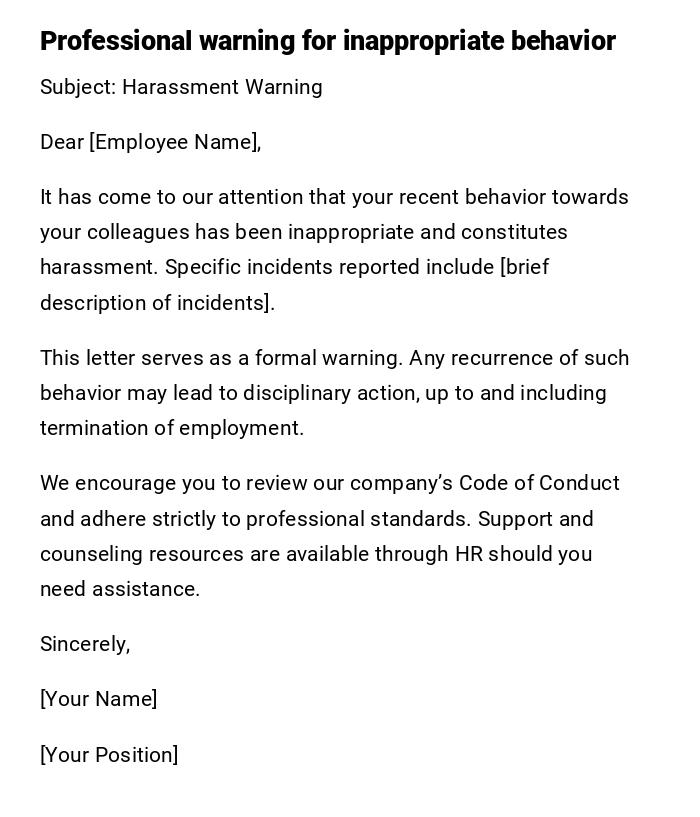
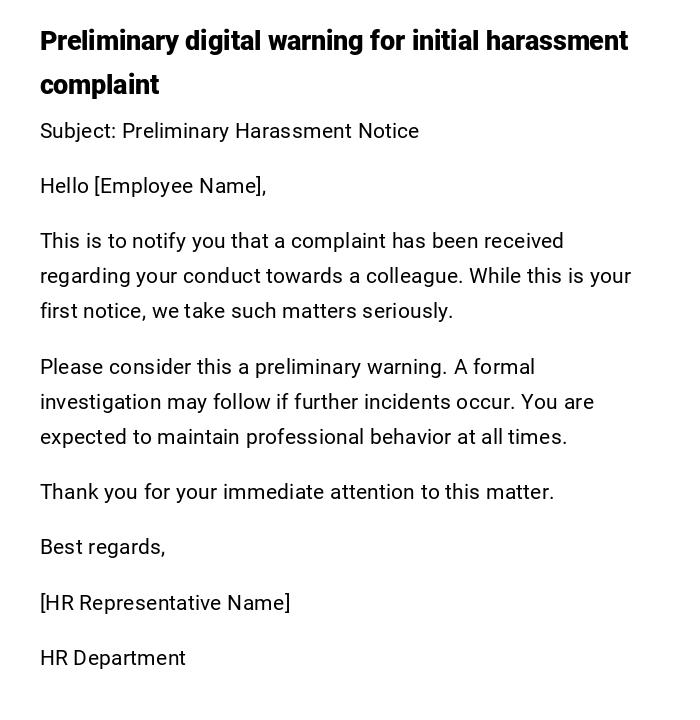
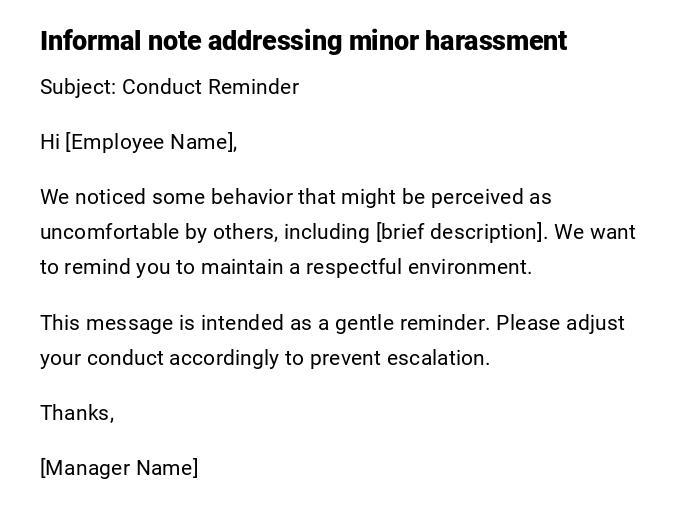
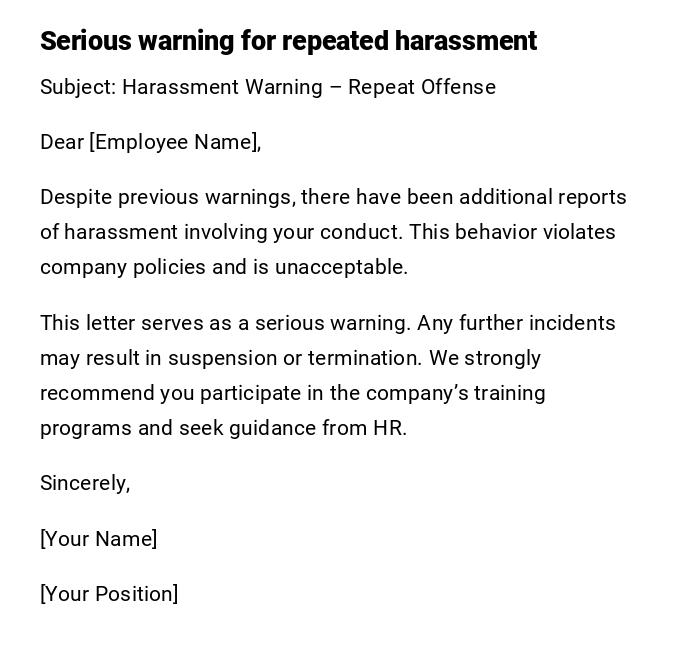
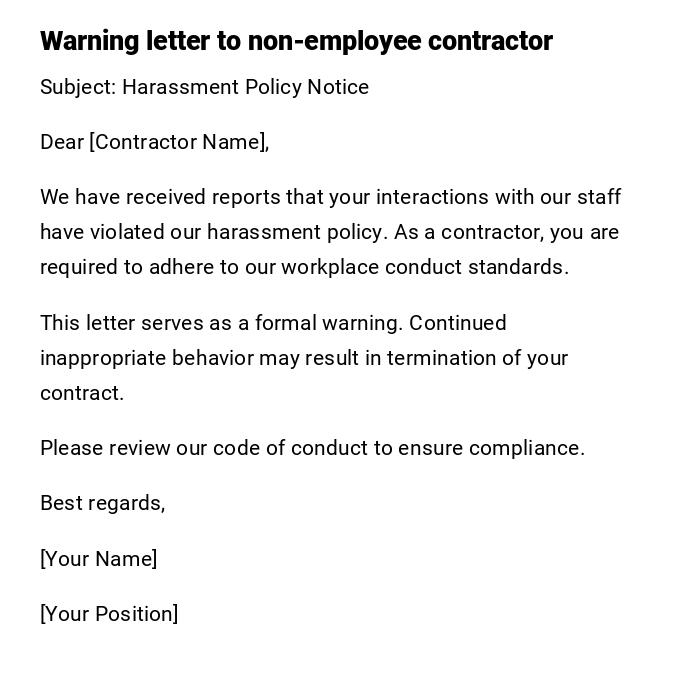
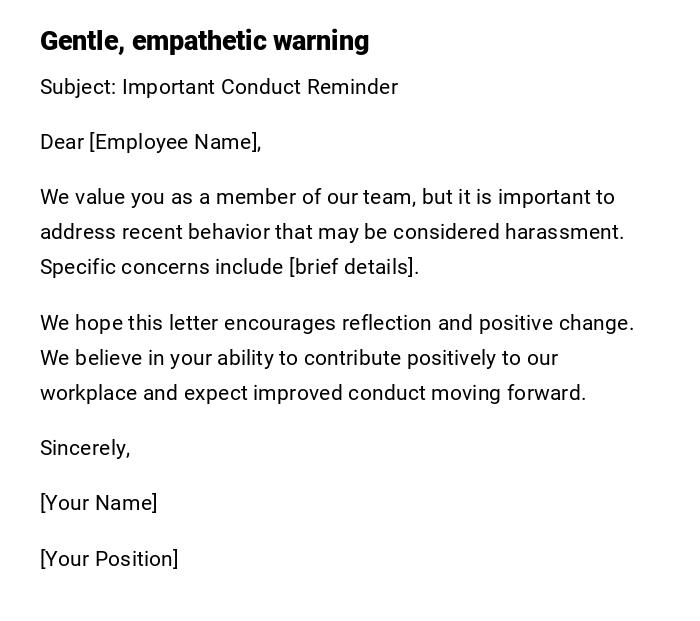

 Download Word Doc
Download Word Doc
 Download PDF
Download PDF